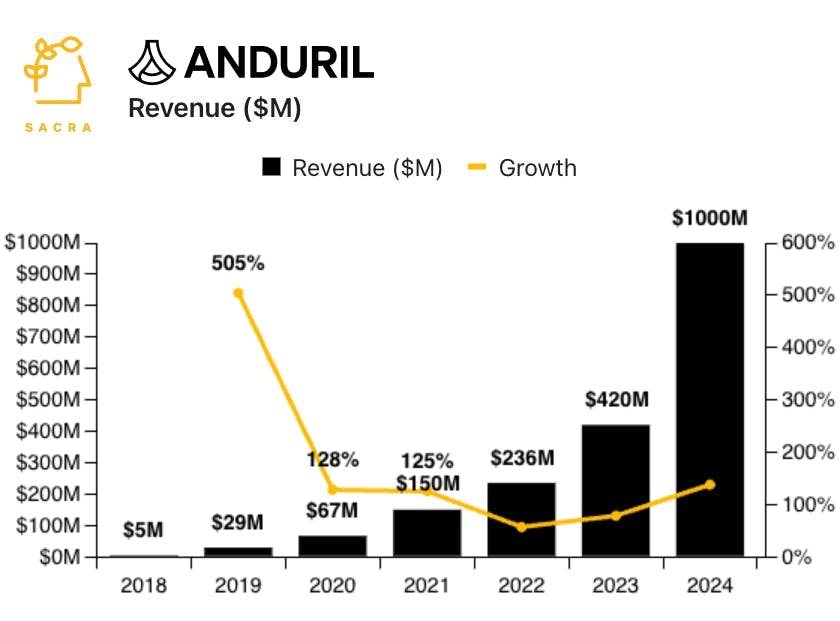America First vs. American Dynamism
 Jan-Erik Asplund
Jan-Erik Asplund
TL;DR: Anduril is riding Europe’s defense wake-up call by building local production and R&D hubs to satisfy sovereignty agendas as the EU proposes €800B in new military spend. On the flip, domestically Anduril are positioned to be one of the big winners of the Pentagon’s proposed ~$250B in budget cuts. For more, check out our full Anduril report and dataset.


Trump's "America First" policies—demanding NATO allies spend 5% of GDP on defense and threatening 10-100% tariffs on European imports—have accelerated Europe's push for defense self-sufficiency. American defense startups like Anduril stand to benefit by diplomatically positioning themselves like domestic suppliers through localization and partnerships.
Key points via Sacra AI:
- After signing its first major European defense deal to sell ~$38M of Altius drones to the UK for use in Ukraine on March 6th, Anduril ($1B revenue in 2024, up 138% YoY) last week announced plans to build a UK drone factory and partner with European defense companies—part of a strategy of localization that started with Anduril Australia (2022) and will now be key for Anduril to capture its piece of the EU’s €800B in proposed new military spend by 2027. By opening subsidiaries like Anduril UK and Anduril Australia, building overseas factories, and partnering with primes like Rheinmetall (Germany), European countries can “buy European” and support local supply chains and workers while getting the advantages of American tech, a strategy that American primes like Boeing (~35% of defense revenue from int’l sales), Lockheed (~27%), and Northrop (14%) have used to sell into Europe, the Middle East, and Asia-Pacific since the 1950s.
- While Anduril has become known for its drones, countering the threat of drones is becoming an even bigger business—earlier this month, Anduril secured 1) a $642M contract with the Marine Corps to build AI-powered anti-drone systems, and 2) a takeover of Microsoft’s $22B IVAS contract to develop mixed-reality goggles for the Army with anti-drone capabilities. While Anduril’s AI-powered drones can cost up to $1M/each, it is the $300-500/each homemade and consumer-tier (DJI Mavic) kamikaze/grenade drones that have inflicted ~80% of all casualties on the battlefield in the Russo-Ukrainian War—signifying the emergence of a major new asymmetric threat to American troops in conflict zones around the world.
- Domestically in the U.S., Anduril stands to win the biggest from the DoD’s plans to cut the Pentagon’s budget by ~$250B by trimming 8% per year for the next 5 years as its entire model of American Dynamism undercuts stagnant incumbents on long cost-plus contracts by building & taking on the risk & cost of R&D upfront, then selling finished products. Allocation is moving away from superprojects like Lockheed Martin’s F-35 program ($2T lifetime cost) and towards the 17 areas the Pentagon has exempted from any cuts, like drones (Anduril, Shield AI, Neros), training (Red 6), nuclear modernization (Kairos Power, Oklo), unmanned ocean vessels (Anduril, Saronic, Saildrone) and homeland missile defense (Anduril, Epirus)—with Anduril as a leader across multiple categories.
For more, check out this other research from our platform:
- Anduril (dataset)
- SpaceX (dataset)
- Anduril, SpaceX, and the American dynamism GTM playbook
- The biggest mistake defense startups make
- Ross Fubini, Managing Partner at XYZ Capital, on the defense tech opportunity
- Shield AI (dataset)
- Scott Sanders, chief growth officer at RRAI, on the defense tech startup playbook



